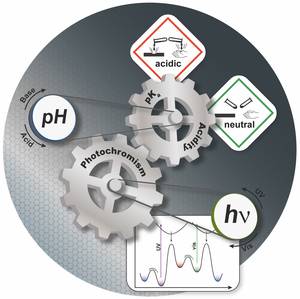Efficient Light-Induced pKa-Modulation coupled to Base-Catalyzed Photochromism
23 March 2018
Hot Paper of Stefan Hecht and coworkers in Angewandte Chemie
Photoswitchable acid-base pairs, whose pKa values can be reversibly altered, are attractive molecular tools to control chemical and biological processes with light. We could now realize a significant, light-induced pKa change of three units in aqueous medium between two thermally stable states, which can be interconverted using UV and green light. The light-induced pKa modulation is based on incorporating a 3-H-thiazol-2-one moiety into the framework of a diarylethene photoswitch, which loses the heteroaromatic stabilization of the negatively charged conjugate base upon photochemical ring closure, and hence becomes significantly less acidic. Importantly, the efficiency of the photoreactions is drastically increased in the deprotonated state, giving rise to catalytically enhanced photochromism. Protonation appears to have a significant influence on the shape of the ground- and excited-state potential energy surfaces. Ongoing work is devoted to further maximizing the extent of light-induced pKa modulation and to shift the operating pH value to physiological conditions to harness our photoswitchable acid-base pairs for the control of biocatalytic processes.
Original publication
Efficient Light-Induced pKa-Modulation coupled to Base-Catalyzed Photochromism
Johannes Gurke, Šimon Budzák, Bernd M. Schmidt, Denis Jacquemin, Stefan Hecht
Angew. Chem. Int. Ed. 2018
DOI: 10.1002/anie.201801270
or in Selected Research Highlights

